Out of the 37 different species of snakes found in North Carolina, a number of them are black, and a few of these black snakes are venomous. Knowing the facts about common black snakes in North Carolina is important so you can properly identify them. What are 6 of the black snakes in North Carolina?
North Carolina offers a diverse range of environments enveloped in hot and humid temperatures for a large portion of the year. This is ideal for snakes which is why so many of them call North Carolina home. Almost all snakes brumate around the same time in North Carolina since the state experiences a noticeable winter.
What are some other interesting facts about 6 of the black snakes in North Carolina? We’ll take a look now.

6 Black Snakes In North Carolina
These are 6 black snakes that are found in North Carolina:
1. Eastern Rat Snake
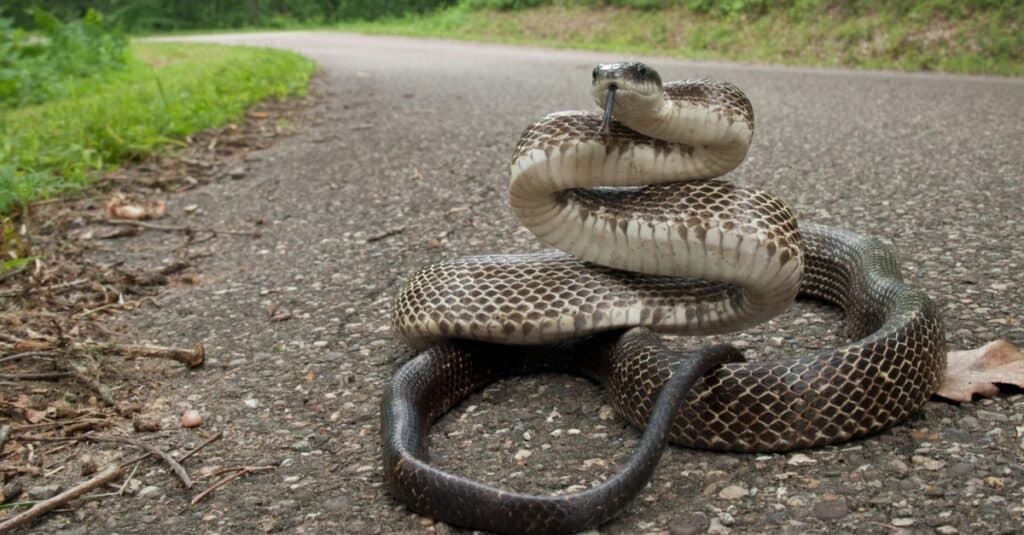
At up to 6 feet long,
rat
snakes are the second longest snake found in North Carolina.
©Mike Wilhelm/Shutterstock.com
Rat snakes are also known as chicken snakes, black rat snakes, pilot snakes, and pilot black snakes. If you’re spotting a black snake in North Carolina, chances are high that it’s a black rat snake. It’s the most common snake in the state, and it often lives right next to humans.
At up to 6 feet long, rat snakes are the second longest snake found in North Carolina. In some parts of the state, they’re greener than black, and some have striped markings. They may also have checkerboard patterning on their bellies.
They’re constrictors that chow down on rodents, other small mammals, birds, and bird eggs. Domestic poultry is a high-ranking menu item for these snakes, making them a pest to some. They’re arboreal and spend a large portion of their day off the ground.
2. Cottonmouth
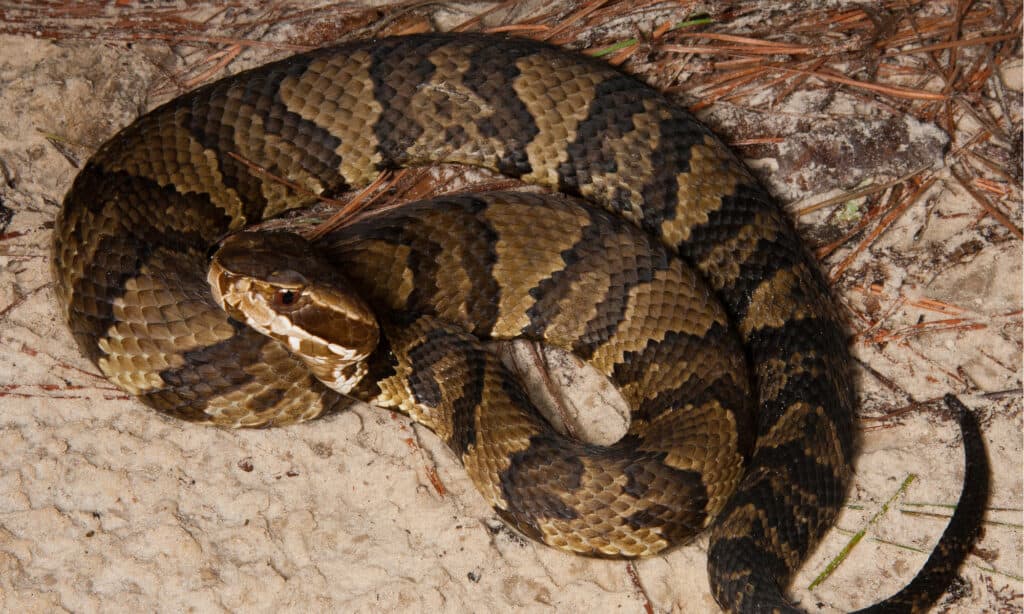
Cottonmouths are the only venomous water snake in the
United States
.
©Nathan A Shepard/Shutterstock.com
Cottonmouths grow up to 4 feet long and are highly venomous. While some are dark brown because of their aquatic lifestyle, almost all cottonmouths appear jet-black when wet or swimming. They’re known as cottonmouths because of their signature white mouth interiors that they display when threatened.
They’re found along the east coast of North Carolina, and they’re almost always in or near a permanent water source. They’re also known as water moccasins. Cottonmouths are the only venomous water snake in the United States.
These snakes are long and girthy. They grow up to 4 feet long on average, and because they’re muscular, they appear almost bulky for their speed. Despite appearances, they’re light for their size and generally don’t weigh more than 5 pounds.
Anecdotal reports state that individuals reach up to 9 feet long. However, finding a contender above 5 feet in length is rare. They make a meal of salamanders, rodents, chickens, turtles, birds, and other prey they come across in their environment.
3. Northern Black Racer
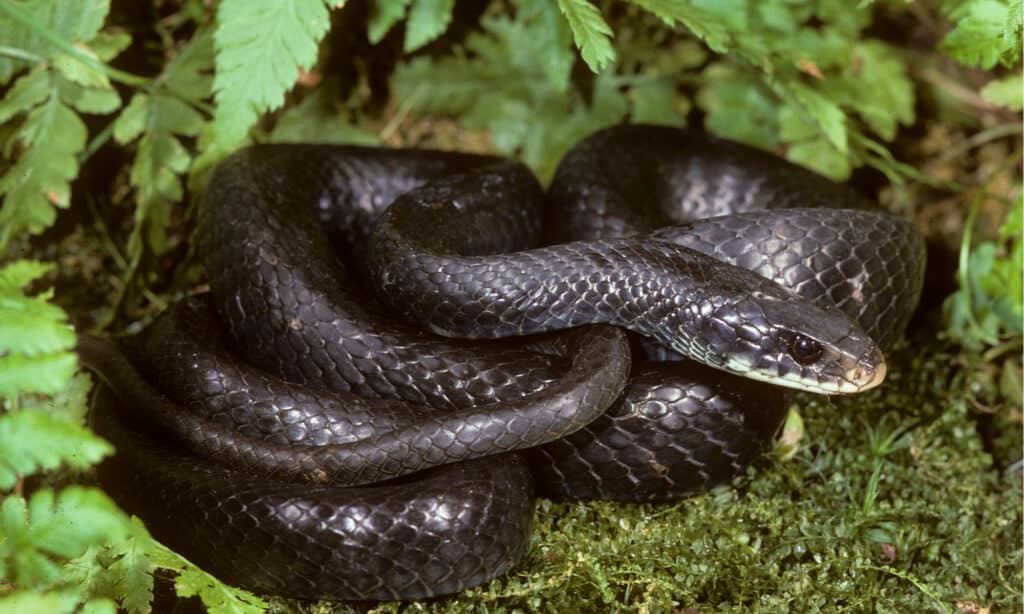
Northern black
racers
shake their tails in the grass like a rattlesnake to deter a threat before striking.
©Breck P. Kent/Shutterstock.com
Also called North American racers, these snakes are all black except for their light grey bellies. The largest black racer ever recorded was over 6 feet long, but they usually top out at about 5 feet. They’re thin and long like a garden hose.
These snakes are nonvenomous. They are known to lash out and bite if cornered though they’ll almost always flee if they can. Northern black racers shake their tails in the grass like a rattlesnake to deter a threat before striking.
Racers are swift and travel up to 10 mph. They eat birds, eggs, lizards, and rodents. Some individuals have distinctive white chins.
4. Black Swamp Snake
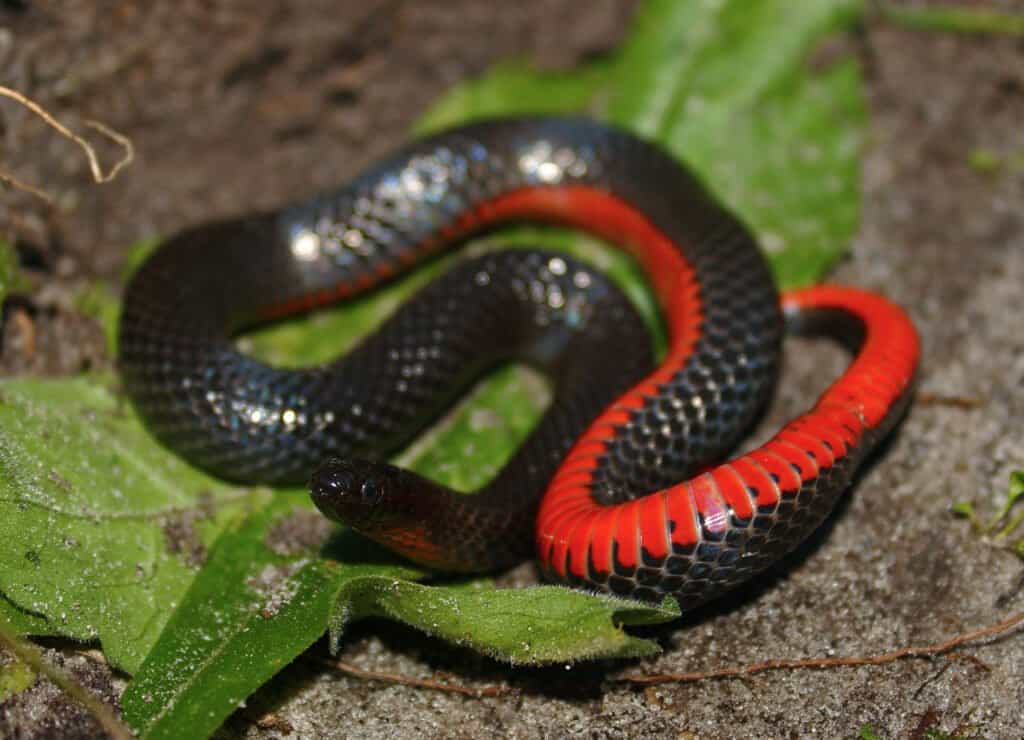
Black swamp snakes
only occur near the coastline and aren’t found everywhere in North Carolina.
©Peter Paplanus / flickr – License
Also known as the Carolina swamp snake, these snakes are small and don’t grow more than a foot and a half in length. They hang out in wet landscapes like marshes and swamps. They have a red or orange belly which starkly contrasts their black body.
Black swamp snakes only occur near the coastline and aren’t found everywhere in North Carolina. They aren’t easy to spot as they’re good at hiding in aquatic vegetation in shallow water.
They’re abundant in the few spots they do live, so if you go looking for one, you’ll find it. Black swamp snakes are nonvenomous. They hunt for leeches, tadpoles, frogs, and small fish both during the day and at night.
5. Timber Rattlesnake
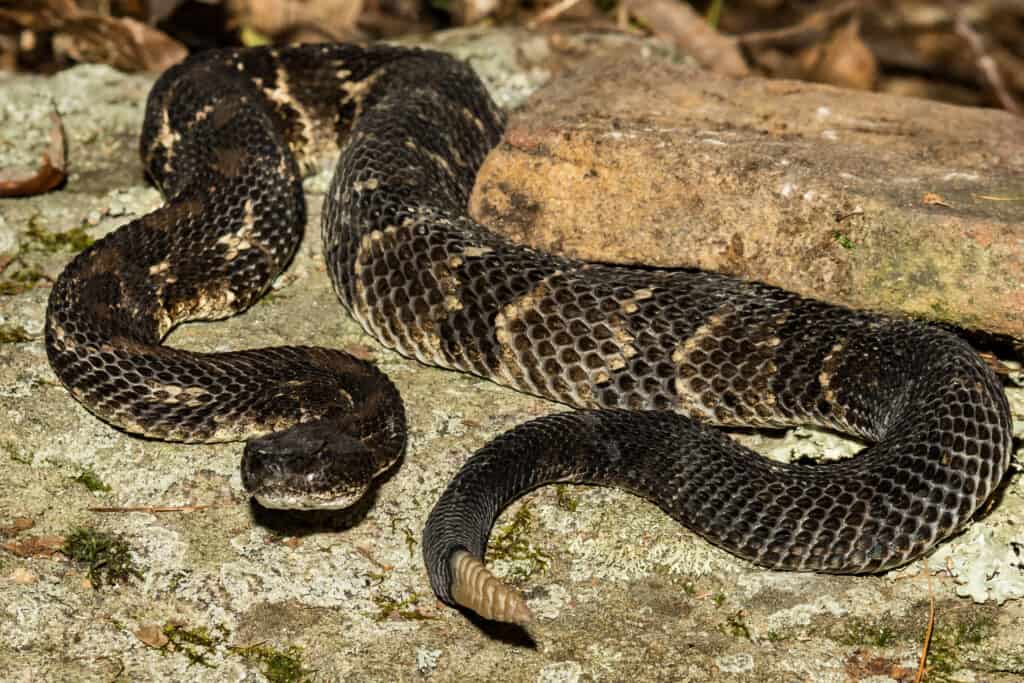
The number of
timber rattlesnakes
in North Carolina is shrinking due to habitat fragmentation.
©iStock.com/JasonOndreicka
Like all rattlesnakes, the timber rattlesnake is venomous, which makes it one of the most dangerous snakes in North Carolina. It’s a member of the pit viper family, which means it has heat-sensing pits on either side of its face, which it uses to detect its prey.
While most timber rattlesnakes are not black, there are enough individuals in North Carolina that are completely black that they’re worth mentioning on any list of black snakes in the state. They reside in the coastal plains and the mountains.
These rattlesnakes are usually banded, but the black morph of timber rattlesnakes in North Carolina is so dark that this banding isn’t detectable. It’s found mainly in rural areas as it’s been displaced from cities.
The number of timber rattlesnakes in North Carolina is shrinking due to habitat fragmentation. Roads and other human endeavors are fracturing this snake’s territory, harming the sustainability of a widespread population.
Both kingsnakes and eastern indigo snakes eat timber rattlesnakes, and that’s because they are immune to rattlesnake venom. Other common snake predators are owls, skunks, bobcats, and coyotes. Timber rattlesnakes stick to a diet consisting of small mammals and reptiles.
6. Ringneck Snake
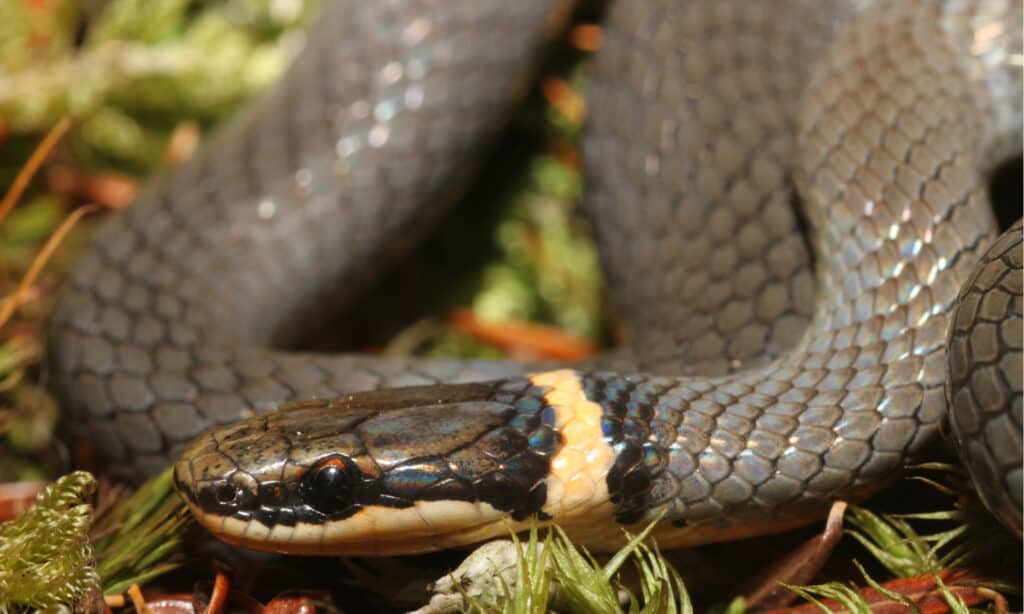
They’re called ringneck snakes because of the bright collar-like ring they have around their necks.
©/Shutterstock.com
These snakes aren’t spotted often as they avoid human contact as best as they can. Like other snakes on this list, not all ringneck snakes are black. However, there are enough predominantly black individuals in North Carolina for them to find a place on our list of black snakes in the state.
They’re called ringneck snakes because of the bright collar-like ring they have around their necks. These neck rings range in color but are generally a bright orange or yellow. They’re one of the smallest snakes in the world, coming in at under a foot in length.
A ringneck snake spends most of its time hiding, and it hunts along waterways for its prey. Ringneck snakes eat slugs, worms, toads, newts, and frogs. Their saliva contains mild venom that affects small prey, but they are not dangerous to humans.
Summary Of The 6 Black Snakes In North Carolina
| Rank | Black Snake | Venom Dangerous to Humans? |
|---|---|---|
| 1 | Eastern Rat Snake | No, they are non-venomous |
| 2 | Cottonmouth | Yes |
| 3 | Northern Black Racer | No, they are non-venomous |
| 4 | Black Swamp Snake | No, they are non-venomous |
| 5 | Timber Rattlesnake | Yes |
| 6 | Ringneck Snake | No, they have mild venom that affects small prey |
What State Has the Most Snake Attacks?
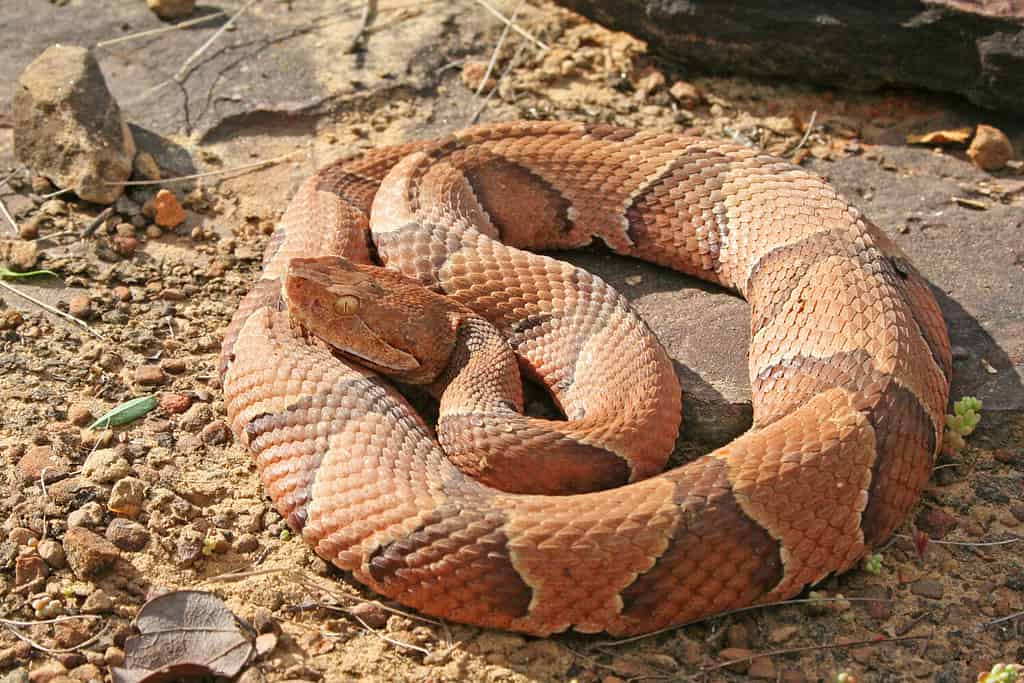
The venomous copperhead snake is among the snakes responsible for snake bites in North Carolina.
©Creeping Things/Shutterstock.com
What state ranks the highest in snake bites annually? Believe it or not, that would be North Carolina. The state’s snake bite rate is 157.8 bites per million population per year. How does that average out? Well, the population as of 2021 was a little over 10 million (10.55 to be exact). If we were to just figure it off of 10 million, that would mean that there are roughly 1,580 reported snake bites per year.
The top 6 states for reported snake bites are as follows:
- North Carolina–157.8 bites per million
- West Virginia–105.3 bites per million
- Arkansas–92.9 bites per million
- Oklahoma–61 bites per million
- Virginia–48.7 bites per million
- Texas–44.2 bites per million
In North Carolina, there are 6 different kinds of venomous snakes: copperhead, cottonmouth, timber rattlesnake, pigmy rattlesnake, eastern diamondback rattlesnake, and eastern coral snake. In 2019, 92 people were bitten by venomous snakes in that state.
The photo featured at the top of this post is © Tom Fenske/Shutterstock.com
Discover the "Monster" Snake 5X Bigger than an Anaconda
Every day A-Z Animals sends out some of the most incredible facts in the world from our free newsletter. Want to discover the 10 most beautiful snakes in the world, a "snake island" where you're never more than 3 feet from danger, or a "monster" snake 5X larger than an anaconda? Then sign up right now and you'll start receiving our daily newsletter absolutely free.
Thank you for reading! Have some feedback for us? Contact the AZ Animals editorial team.






